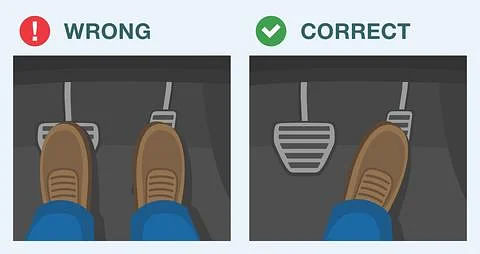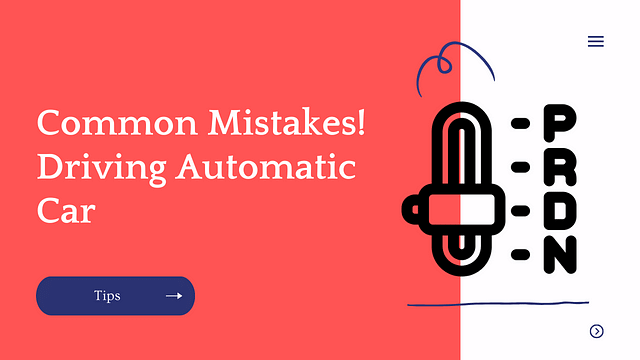Common mistakes you should avoid while driving an automatic car!
Hello everyone, how are you? I hope you are all well and in good health. On this content, I will answer request from friends about the mistakes that drivers often do while driving automatic cars.
a few days ago I have discussed common mistakes that are often made by manual car users, this time I will discuss common mistakes that are often made by automatic car users.
Automatic cars are cars that use automatic transmission gearbox, where the driver does not need to operate the clutch and transmission manually. its very easy and simple to use a car.
Many people choose automatic cars because they provide comfort and convenience in driving, because we don’t need special skills to operate them. just put the gear in D and you can drive.
Even though automatic cars provide comfort and convenience in driving, there are still many automatic car users who make fatal mistakes that can cause damage to the car. and even the car owner doesn’t know about it.
Understanding the nuances of driving an automatic car is crucial for both the safety and the longevity of your vehicle. Unlike manual vehicles, automatic cars offer a simplified driving experience by removing the need to shift gears manually.
However, this doesn’t mean you can go on autopilot. Even with their user-friendly nature, automatic cars demand certain savvy from their drivers. Here are five common mistakes that you should steer clear of to become top-notch at the wheel.
Shifting the gear to Neutral (N) while sliding down a slope
Switching into neutral while the car is in motion disengages the engine from the wheels, meaning you lose control and the ability to immediately respond to changes in road conditions or traffic.
Additionally, in modern vehicles, this maneuver can hinder fuel efficiency as certain models might cut off fuel in the coasting or engine braking mode.
Sliding down a slope in neutral can put the braking system under stress conditions and can cause brake failure. It is always recommended to use the engine braking system by shifting the gear to D or L to maintain control and reduce the risk of brake failure.
Not only that, it helps brake pads and rotors last longer, saving you money in the long run.
Shifting the gear to Neutral (N) at a stoplight
There are misconceptions that shifting to neutral at a stop light can save fuel. However, this is not true. In fact, it can be dangerous in some conditions.
When you shift to neutral, you lose the ability to accelerate quickly if needed. This can be dangerous in situations where you need to quickly move out of the way of an oncoming vehicle or avoid an accident.
Nowadays, modern cars are equipped with hi-technology, which automatically shuts off the engine when the car is stopped and restarts it when you take your foot off the brake. This technology is designed to save fuel and reduce emissions.
So you don’t have to worry about fuel consumption when you are at stoplight, just keep the gear in D and enjoy the ride.
Shifting the gear to Park (P) before coming to a complete stop
its parking mode not for stop the car, Shifting to parking mode before coming to a complete stop can cause damage to the transmission system.
You can damage The parking pawl, a small metal pin in the transmission, is designed to prevent the car from moving when in park.
To avoid damaging the transmission system, always come to a complete stop before shifting to the park. This will help prevent unnecessary wear and tear on the transmission system and extend the life of your vehicle.
And if you park on a slope, make sure the car stop completely and make sure the car stop rely on the handbrake not the parking mode.
Shift the gear to Reverse (R) while driving forward
Shifting from ‘D’ (Drive) to ‘R’ (Reverse) before the car has fully stopped can cause serious transmission issues and is extremely unsafe. Very harmful to the transmission system.
This can cause the transmission to lock up, which can lead to costly repairs. you don’t want to spend your money on this kind of mistake?
Best practice - Ensure your car has fully come to a stop before putting it in reverse. Some models incorporate a safety measure that requires the car to be completely still before shifting into reverse, but it’s always best to develop the habit.
Placing both feet on the pedals

Using both feet to brake and accelerate can be a recipe for disaster. The most common mishap is pressing the gas and brake simultaneously, which drastically compromises your ability to control the vehicle.
The Single Foot Safety Rule - Practice using only your right foot for both acceleration and braking. It’s a simple technique that yields precise control over your car and can prevent unintentional acceleration, making your driving smoother and safer.
If you’re accustomed to using two feet, breaking the habit can take time, but it’s well worth the effort.
Conclusion
Driving an automatic car may be a breeze compared to a manual, but that doesn’t mean it’s error-proof. By avoiding these common mistakes, you can ensure a smoother, safer, and longer driving experience—both for you and your car.
Remember, vehicles are not only a means to get from point A to point B but they’re also a large investment in your safety and security on the road. By being diligent with your driving habits, you protect not only your assets but also yourself and your passengers.
